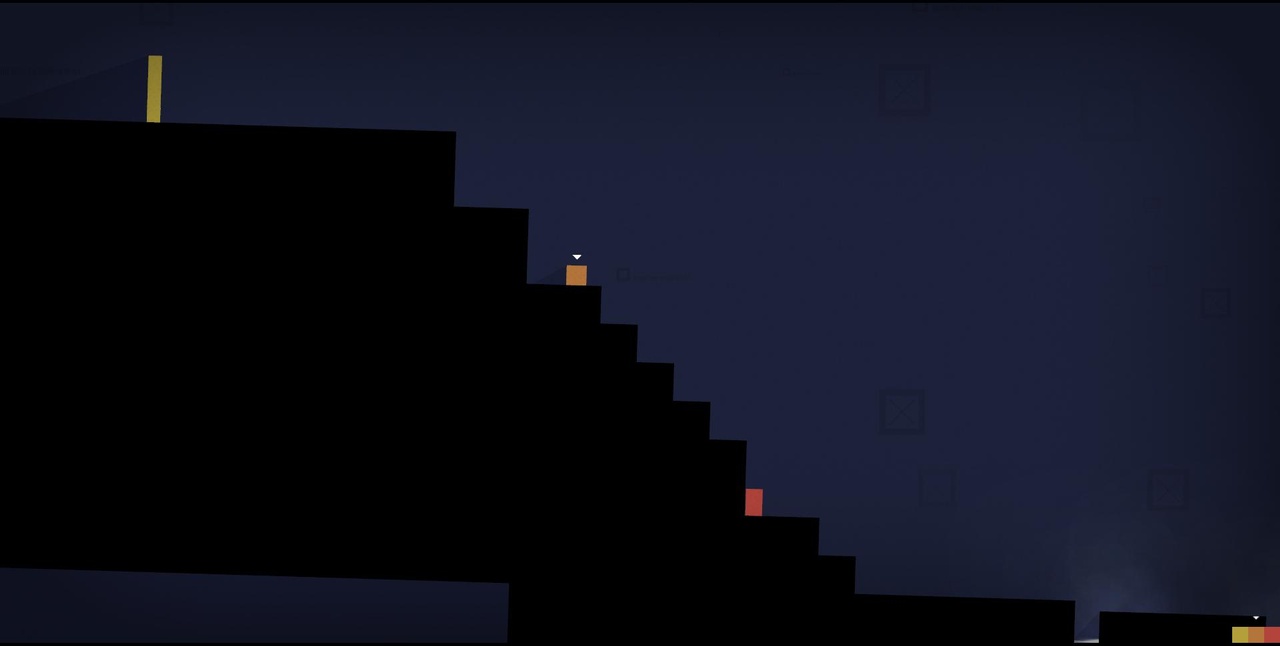John has a big head. Not literally, of course, given that he's just a skinny rectangle. But the yellow string bean sure can jump, especially compared to his squatter, squarer friends, and he takes pride in his superiority. Claire, on the other hand, is borderline delusional. As her buoyant frame glides through the water, she thinks herself a superhero (sans cape) destined to ferry the needy across ponds, proving that not all quadrilaterals sink.
It's not often that ordinary shapes are given distinct names and personalities. Sure, Chris may look like the typical square you would find in a math book, but place him in a puzzling environment with allies who can easily outstrip his meager athletic abilities, and he quickly grows bitter and envious before latching on (both physically and emotionally) to one of his strong protectors. Traits such as these humanize the characters despite their blocky appearances, and transform the abstract world where they reside into a relatable situation in which talent and teamwork intertwine to make anything possible.
Everything starts out with Thomas. A rogue artificial intelligence in a program gone awry, Thomas unexpectedly gains consciousness in a foreign land. Slowly, he becomes cognizant of his abilities. He can slide across the ground, fall dizzying heights without taking a scratch, and hop over moderate obstacles. It's not much, but the stages he finds himself in gradually grow more complex, forcing him to jump with more precision or worm his way up foreboding passageways. Once he orients himself with his surroundings, he happens upon a friend, and Thomas is no longer alone.
Every new character you meet in the adventure is either a square or a rectangle, each sporting different abilities you have to harness. Chris is not much use early on. The other characters have to form makeshift bridges, ladders, and barges to get him safely to the exit, but he eventually makes his worth known. That small passage, a mere sliver in a rock face, is too narrow for anyone to fit in but Chris. You might have cursed him earlier for slowing the group down, but you find that he's indispensable in later situations. Even the less-abled characters have a purpose, and you want to help them not only to usher them to the next stage, but because you grow attached to them.

Strong writing creates strong bonds. Narration plays out during the action, so you listen to a voice-over explaining the mind-set of one or more of the characters as you jump up platforms and avoid spikes. At times you laugh, such as when modern games are unexpectedly evoked after one of the characters taps into a mainframe, but mostly you get absorbed in their stories. The shapes who yearn for companionship make you appreciate their humanity while the ones who want to be alone have a quiet strength. At certain points, a character is lost in a portal and the desperate cries from its companions resonate.There's a strong narrative foundation that meshes wonderfully with the action, creating a cohesive adventure that continually draws you deeper into the tale.
Switching between characters forces you to pass obstacles to progress in different ways. Whereas some characters can easily leap over obstacles, others need a helping hand. In the beginning, this means you stack blocks on top of one another so even your short-hopping companions can reach higher ground, but things grow more complex as more characters and obstacles are introduced. Gravity becomes a suggestion rather than a law, spikes become as dangerous as the acidic water, and jet streams prove that blocks are not the slightest bit aerodynamic. The sheer variety spread across the hundred levels ensures that every stage presents a new danger, and that combined with the quick pace keeps you fully invested in the action.
Although the inventiveness keeps you on your toes, ideas aren't fully realized before a new one is introduced. Because of that quick transition and the smooth difficulty curve that comes with every new obstacle, there is rarely any genuine challenge to force you to pause and reflect. Thomas Was Alone is a puzzle platformer where you're rarely vexed. Because the character traits are so straightforward, and the obstacles present danger in only one way, you almost always know exactly what you need to do to progress, and it's just a matter of rounding up the cubes and setting off. This easiness doesn't detract from the experience while you're playing, because you care about getting your friends to safety, but when the credits wrap up and you reflect on what happened, an empty feeling emerges where satisfaction should reside.

Although a pixelated cloud is strongly hinted to be a malevolent force, there are never any enemies to hinders your progression. The focus is on jumping and problem solving, and it's refreshing to play a game so keyed in on its own strengths. In fact, there are only a couple of levels where failure surfaces because you were too slow. For the most part, you're given all the time you need to figure out what to do, which creates an engrossing atmosphere as you contemplate the environment and let the music wash over you.
Thomas Was Alone is a modest adventure that makes great use of its sparse elements to draw you in. It's disappointing that a controller is not supported natively, but even using a keyboard to guide your rectangular friends doesn't hinder your ability to get them to safety. Short and sweet without any filler, Thomas Was Alone is a worthwhile experience that rises above its basic mechanics to prove heartfelt and engaging in unexpected ways.